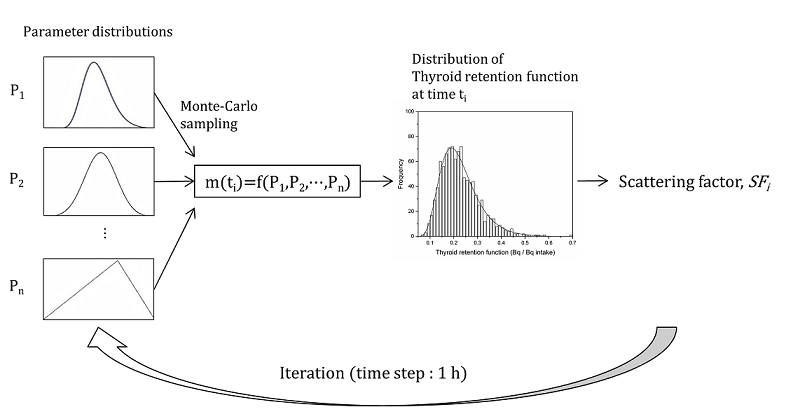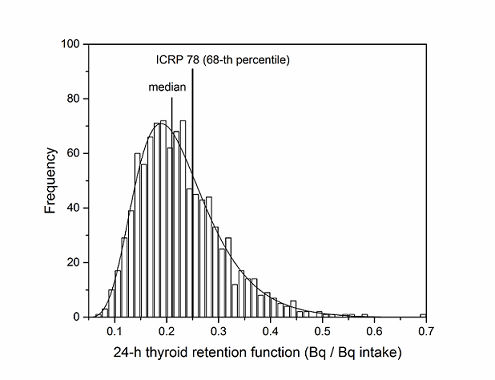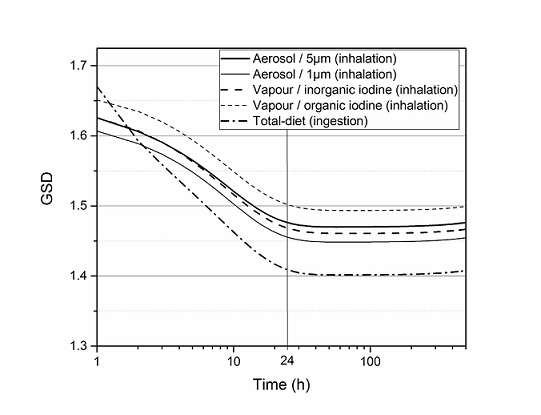글로벌 연구동향
방사선방호 및 안전
- [J Radiat Res.] Uncertainty quantification of bioassay functions for the internal dosimetry of radioiodine 방사성요오드의 내부피폭평가를 위한 갑상선잔류 함수 불확도 정량화
KIRAMS / 권태은*
- 출처
- J Radiat Res.
- 등재일
- 2020 Nov 16
- 저널이슈번호
- 61(6):860-870. doi: 10.1093/jrr/rraa081.
- 내용
-
Abstract
Bioassay functions, which are provided by the International Commission on Radiological Protection, are used to estimate the intake activity of radionuclides; however, they include considerable uncertainties in terms of the internal dosimetry for a particular individual. During a practical internal dose assessment, the uncertainty in the bioassay function is generally not introduced because of the difficulty in quantification. Therefore, to clarify the existence of uncertainty in the bioassay function and provide dosimetrists with an insight into this uncertainty, this study attempted to quantify the uncertainty in the thyroid retention function used for radioiodine exposure. The uncertainty was quantified using a probabilistic estimation of the thyroid retention function through the propagation of the distribution of biokinetic parameters by the Monte Carlo simulation technique. The uncertainties in the thyroid retention function, expressed in terms of the scattering factor, were in the ranges of 1.55-1.60 and 1.40-1.50 for within 24 h and after 24 h, respectively. In addition, the thyroid retention function within 24 h was compared with actual measurement data to confirm the uncertainty due to the use of first-order kinetics in the biokinetic model calculation. Significantly higher thyroid uptakes (by a factor of 1.9) were observed in the actual measurements. This study indicates that consideration of the uncertainty in the thyroid retention function can avoid a significant over- and under-estimation of the internal dose, particularly when a high dose is predicted.
Figure 1. Schema for probabilistic estimation of the thyroid retention function.

Figure 2. Distribution of thyroid retention function at 24 h

Figure 3. Time-dependent geometric standard deviations of the distributions of thyroid retention functions
Affiliations
Tae-Eun Kwon 1 2 , Yoonsun Chung 2 , Jaeryong Yoo 1 , Wi-Ho Ha 1 , Minsu Cho 1
1 National Radiation Emergency Medical Center, Korea Institute of Radiological and Medical Sciences, 01812, Seoul, Republic of Korea.
2 Department of Nuclear Engineering, Hanyang University, 04763, Seoul, Republic of Korea.
- 키워드
- retention function; internal dosimetry; probabilistic estimation; thyroid dose; uncertainty in bioassay.
- 연구소개
- 방사성요오드 섭취로 인한 내부피폭 선량을 평가하기 위해서는 국제방사선방호위원회(ICRP) 등에서 제공하는 갑상선 잔류함수(Thyroid retention function)를 사용하여 방사능 섭취량을 먼저 추정해야 합니다. 하지만 단일 값으로 주어지는 갑상선 잔류함수는 생리역동학 모델에 대한 정확한 지식 부재(lack of knowledge), 개인간의 다양성(inter-individual variability) 등 여러 가지 요인에 의한 상당한 불확도를 내포하고 있기 때문에 이러한 불확도에 대한 지식 없이 선량을 평가할 경우 상당히 편향된 결과를 초래할 수 있습니다. 따라서 본 연구에서는 몬테칼로 기법을 통해 단일 값이 아닌 확률론적 갑상선 잔류함수 산출하여 그 불확도를 정량화 하였습니다. 본 연구의 결과는 내부피폭 선량평가자들로 하여금 갑상선 잔류함수에 대한 불확도를 고려하여 보다 더 합리적이고 정확한 내부피폭 선량평가를 가능하게 합니다.
- 덧글달기









